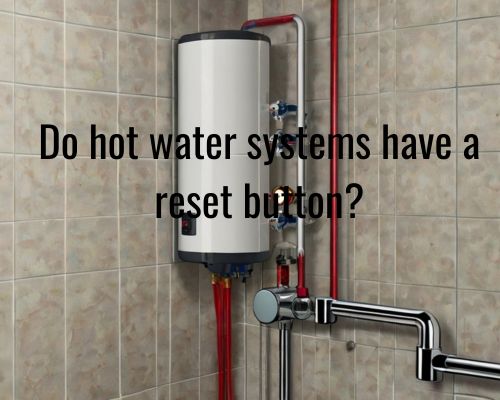Hot water systems, whether electric or gas-powered, are equipped with a reset button as a crucial safety feature.
For electric water heaters, you will typically find the reset button near the thermostat.

This button, often called the high limit switch, is designed to shut off the heater when the water temperature becomes dangerously high, preventing potential hazards.
For gas water heaters, the reset button is usually located behind the thermostat panel. This button also acts as a safety mechanism, ensuring that the pilot light re-ignites and the system resumes heating properly.
Understanding how to locate and use this button can save you time and potentially costly repairs.
You might be wondering why your water heater needs a reset button in the first place. The button’s primary function is to protect your heating system from overheating, which could lead to severe damage or even explosions.
Knowing how and when to use this reset feature is vital for maintaining the safety and efficiency of your hot water system. Let us have a clear understanding on this with Plumber Warragul.
Understanding the Reset Button on Water Heaters
Water heaters, whether electric or gas, are equipped with reset buttons as a safety feature to handle specific faults. The reset button plays a crucial role in ensuring the proper functioning of the system by addressing issues such as overheating and circuit interruptions.
Location and Function of the Reset Button
The location of the reset button varies depending on the type and model of the water heater.
On electric water heaters, the reset button is typically found behind the access panel, often covered by insulation and located near the thermostat. You may need to remove the cover plate to access this red button.
For gas water heaters, the reset button is usually on the thermostat panel. To access it, you may need to remove the cover.
Once located, the button should be pressed and held for a few seconds to reset the system.
The primary function of the reset button is to act as a safety device that trips when a fault occurs. It helps prevent potential hazards by shutting down the heating elements when overheating or electrical issues are detected.
Reasons for Tripping the Reset Button
Several factors can cause the reset button to trip.
A common cause is overheating due to a faulty thermostat. Thermostats regulate the temperature of the water, and if malfunctioning, can cause the water to overheat, triggering the reset button.
Another reason includes issues with the heating elements. If a heating element shorts out or becomes faulty, it can lead to excessive temperature buildup. The reset button will trip as a preventive measure to avoid hazards.
Wiring problems and circuit breaker tripping are also common culprits. Poor wiring connections or electrical shorts can result in the reset button activating. Regular maintenance can help identify and fix these issues before they cause disruptions.
In gas water heaters, the reset button might trip if there are problems with the pilot light or the gas supply. Ensuring these components are functioning correctly can help maintain the system’s stability.
Step-by-Step Guide to Resetting Your Water Heater
Resetting your water heater requires certain precautions and preparations. This guide will provide clear steps for both electric and gas water heaters, and offer troubleshooting tips if the reset doesn’t work.
Precautions and Preparations
Before beginning, ensure you follow necessary safety steps.
Turn off the power supply to prevent any electrical hazards.
For electric water heaters, switch off the circuit breaker, while for gas heaters, turn off the gas valve.
Check for any visible leaks around the heater. Leaks may indicate a more serious issue that could require professional help from a plumber or electrician.
Gather the required tools, which typically include a screwdriver. Make sure you allow the heater to cool down completely to avoid burns.
Resetting the Electric Water Heater
Locate the reset button, usually found on the thermostat or heating element panel, behind a small cover secured with screws.
Using a screwdriver, remove this cover to expose the reset button.
Press the reset button firmly until you hear a click. This click usually indicates that the heater has been successfully reset.
Restore power by switching the circuit breaker back on. Wait a few minutes to allow the system to start heating again.
Monitor the temperature settings to ensure the heating element resumes normal operation. You should set the thermostat between 50-60 degrees Celsius for optimal performance.
What to Do If the Reset Doesn’t Work
If the reset doesn’t resolve the issue, additional troubleshooting may be necessary.
Check the circuit breaker to ensure it hasn’t tripped again.
Inspect the heating element and thermostat for any visible damage or signs of malfunction.
In cases where you identify a leak or other serious issues, it is crucial to seek professional help.
Contact a qualified plumber like Plumber Warragul, or electrician to prevent further damage and ensure safety.
Verify the power supply and confirm there are no power outages affecting your area.
If the heater still doesn’t work after these checks, replacing components like the thermostat or heating element might be necessary.
Ensure all components are properly installed and secure.
If issues persist, professional assessment is advised to avoid potential hazards.